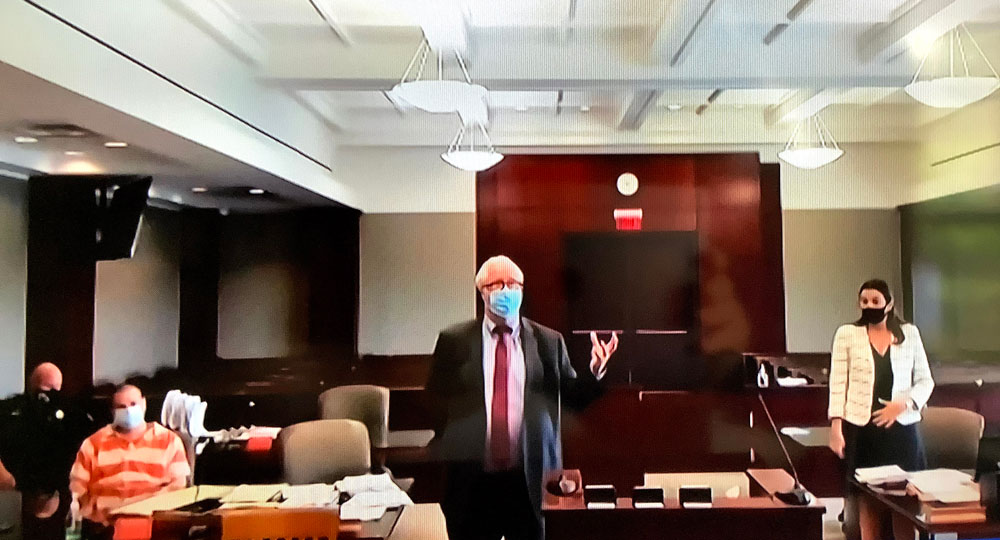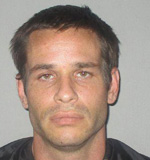
Keith Johansen, the 36-year-old former resident of 23 Felter Lane in Palm Coast, was charged with first-degree murder three weeks after his wife, Brandi Celenza, was found dead at the couple’s home of a gunshot wound in early April 2018. Her 6-year-old son was in the house at the time of the shooting.
Johansen’s trial is scheduled for October. He contends Celenza shot herself. He’d called 911 after the shooting. Detectives and the prosecution have amassed indoor surveillance video they say will prove otherwise, though the moment of the shooting itself was either deleted before authorities seized the evidence, or not recorded–itself a form of absent evidence the prosecution will attempt to turn to its advantage. Two days before Celenza’s death, a camera had been pointed in the bedroom exactly where she was located when she was dead. But the day of her death, the camera was no longer there.
Johansen had rigged the house with an unusual amount of cameras that recorded his family nearly at all times.
Johansen and his attorney, Garry Wood, were in court today before Circuit Judge Terence Perkins to argue three motions to suppress–attempts to keep statements or evidence out of the trial and out of the jury’s view altogether. They went two-for-three. But their wins were on minor elements: statements the 6-year-old boy had made, and statements Johansen had made to the sheriff’s chaplain. And the judge has yet to rule on the admissibility of video evidence that may prove very damaging to Johansen’s case, showing him to be homophobic, misogynistic and racist. None of these elements make him a murderer, but the prosecution is seeking to use them as context for his motive to prove the allegation that he killed Celenza.
The 6-year-old boy who’d been in the house “said that he heard his mother scream. Does he lie?” detective Nicole Thomas had asked Johansen during the investigation.
“Yes, he lies all the time,” Johansen told her.
“Does he tell you that his Mom screams regular in the bedroom? Does he tell you his mother screams and it be a lie?” she asked him, according to one of the motions. “Why on this date, would he lie about his mother screaming in the bedroom?” Johansen’s answer is not given. Since Assistant State Attorney Jennifer Dunton said she was not calling the boy as a witness and had no objection to suppressing the statement, the judge granted the defense’s motion.
But the defense lost on the more crucial matter of Johansen’s hours of interviews with detectives. The defense has argued in an earlier motion that Thomas and Hristakopoulos during their interviews with Johansen “expressed their personal opinions of [Johansen’s] guilt, as well as the victim’s family life and character.” Today Wood argued that hours of interview should be excluded from trial because Johansen, past a certain point in the interrogations, was no longer at the sheriff’s office of his own free will.

Perkins repeatedly asked Wood to point out in the transcript or in video of the interviews at what point the interrogations turned from voluntary to “custodial” (meaning that Johansen was being detained or arrested). Wood could not.“It wasn’t until the tail end of that time, it’s obvious that finally the detective Mirandized him,” Wood said of the moment when Johansen was read his constitutional rights and he invoked his right to a lawyer, shutting down the interview.
Hristakopoulos, called as a witness today, said Johansen had been free to leave up to that point.
“At what point in time during all of this, after being told you’re free to leave, would a reasonable person think, ‘Wait a minute. I’m really not free to leave, this is essentially equivalent to an arrest?’” Perkins asked. “When did that happen? When does this what appears to be a consensual interview turn into a custodial interview?” The judge wanted Wood to point out the exact point. Wood said he couldn’t point to a “specific line” in the transcript–as, in fact, such lines can be very fluid. Perkins looked for “bright-line” events: the handcuffing of Johansen or any other form of restraint. He said he couldn’t find any.
“He wasn’t arrested, he wasn’t taken into custody in any event, he wasn’t threatened to be taken into custody,” Perkins said, explaining his ruling. “He wasn’t threatened if you didn’t go. The only thing that I could see that would in any way raise someone’s suspicion about him I suspect is, he was taken in a police car to the sheriff’s office. He really wasn’t able to be interviewed at the scene in light of the investigation that was conducted, the scene investigation that they were doing at the time. So I can’t really say going to the police station was in and of itself a bright line that was crossed in this circumstance.” The judge also pointed out that Johansen had “no problem” with giving a statement, and was reassured by a detective that he should be comfortable. “We don’t want to add any trauma to what’s going on,” one of the detectives told him.
“So again, I think the evidence supports this is a consensual interview, really, that was initiated as much by Mr. Johansen probably as the investigating officers and detectives in that regard,” the judge said. The motion to suppress those hours of interviews was denied. The jury will get to see any portions the prosecution chooses to show (the defense, too, can show its own portions if it chooses to.)
Celenza died on April 7. The indoor surveillance recordings the judge has yet to rule on are a series of clips from April 5 and April 7. The defense has different issues with the video clips–their arbitrariness, what triggers their beginning and end, and their content.
The couple had been in “heated” arguments recorded on April 5, according to Johansen’s arrest report. Johansen is heard telling Celenza, “I am not going to allow you to hurt me anymore,” and “Maybe we will not get back together,” and “You make me sick.” In another clip, he insinuates that she’s been with a Black man, using racist epithets, saying he hopes she won’t get a “n— baby.” The defense calls it a “completely irrelevant statement,” though it’s preceded by a threat to kill Celenza, who is masturbating on the bed (“Tell me you were not masturbating in that tub or I’ll kill you.” Other clips similarly combine threats of violence by Johansen with threats to kill her and other vile wishes (“Hope you get aids/hope your insides fall out/I am going to get away from you or I am going to kill you).
There is also this, which the prosecution would find relevant in light of his having been the one to call 911: “I am going to take the thing and beat the shit out of you and call the cops myself,” he tells her the night of April 5, “just so I wouldn’t have to see you again. Go ahead and call the cops on me for threatening you, so that I can get rid of you and end you.” The defense claims the statement is “unduly prejudicial” and irrelevant, though the defense uses a strange argument: it’s irrelevant because no similar statements were made the day of Celenza’s death (at least none captured on video).
Several additional clips are transcribed, reflecting the same virulence of insults, misogynistic insults, threats and viciously sadistic descriptions of wishful violence he spoke of carrying out on the victim. After telling her “I want to just hurt you and just leave the state,” he “goes around the side of the bed and gets out a handgun and puts it on the bed beside her and suggests that she ‘use it,'” according to the defense’s description in its motion to suppress. “Then he picks the gun up off the bed and walks around with it. He says that maybe he will haunt her with it. Out of view you hear a click of some kind.”
The defense argues: “In addition to the issues of lack of relevancy, this video is extremely prejudicial because of the display of a gun. [Johansen] does not threaten Ms. Celenza with the gun directly, and states that she should use the gun on herself.”
Later that night he tells her he’d rather be in prison and tells her to “go with whoever that is so I do not hurt you.” (Johansen’s competency to stand trial had at one point been in question, but not for long.)
The judge has previously granted a defense motion calling for Celenza’s family to be barred from wearing similar-colored clothes to court that bear the sort of “eye-catching slogan demanding ‘Justice for Brandi.'” the right of the victim’s family to attend the trial “must not extinguish the burden on the prosecution to prove their case beyond a reasonable doubt through evidence,” the defense argued. The judge agreed.




























Resident says
Why didn’t he just leave and get a divorce? That poor child.
the dude says
I don’t know about Florida family law.
But in GA had he “just left and got a divorce”, he would’ve been giving up all rights to his child and most of all he’s worked for for his entire adult life.
I suspect Florida family law would’ve done the same or worse.
I’m definitely not excusing this racist a$$hat for what he’s accused of.
But knowing that the laws of state would automatically remove you from your child’s life, and confiscate all you’ve worked for as an adult certainly doesn’t help to diffuse the questionable thoughts and actions of an already deranged mind.
Krissy says
The boy in this story was not his. He wouldn’t been to even win visitation rights if they did divorce
Whathehck? says
Poor child. Let’s hope he doesn’t go to the dark side when he grows up. Let’s also hope that a loving family member takes him in, he will need a lot of hugs and reassurance.